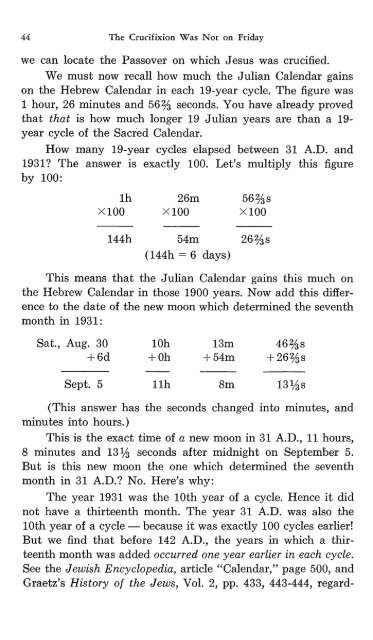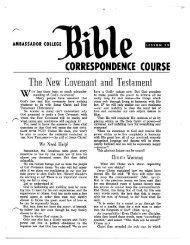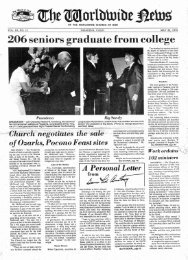Crucifixion Was Not on Friday (1968)_b.pdf - Herbert W. Armstrong
Crucifixion Was Not on Friday (1968)_b.pdf - Herbert W. Armstrong
Crucifixion Was Not on Friday (1968)_b.pdf - Herbert W. Armstrong
Create successful ePaper yourself
Turn your PDF publications into a flip-book with our unique Google optimized e-Paper software.
44 The <str<strong>on</strong>g>Crucifixi<strong>on</strong></str<strong>on</strong>g> <str<strong>on</strong>g>Was</str<strong>on</strong>g> <str<strong>on</strong>g>Not</str<strong>on</strong>g> <strong>on</strong> <strong>Friday</strong><br />
we can locate the Passover <strong>on</strong> which Jesus was crucified.<br />
We must now recall how much the Julian Calendar gains<br />
<strong>on</strong> the Hebrew Calendar in each 19-year cycle. The figure was<br />
1 hour, 26 minutes and 56% sec<strong>on</strong>ds. You have already proved<br />
that that is how much l<strong>on</strong>ger 19 Julian years are than a 19<br />
year cycle of the Sacred Calendar.<br />
How many 19-year cycles elapsed between 31 A.D. and<br />
1931? The answer is exactly 100. Let's multiply this figure<br />
by 100:<br />
1h<br />
x100<br />
26m<br />
x100<br />
56%s<br />
x100<br />
144h<br />
54m<br />
(144h = 6 days)<br />
26%s<br />
This means that the Julian Calendar gains this much <strong>on</strong><br />
the Hebrew Calendar in those 1900 years. Now add this difference<br />
to the date of the new mo<strong>on</strong> which determined the seventh<br />
m<strong>on</strong>th in 1931:<br />
Sat., Aug. 30<br />
+6d<br />
10h<br />
+Oh<br />
13m<br />
+54m<br />
46%s<br />
-I-26%s<br />
Sept. 5<br />
11h<br />
8m<br />
13%s<br />
(This answer has the sec<strong>on</strong>ds changed into minutes, and<br />
minutes into hours.)<br />
This is the exact time of a new mo<strong>on</strong> in 31 A.D., 11 hours,<br />
8 minutes and 13lh sec<strong>on</strong>ds after midnight <strong>on</strong> September 5.<br />
But is this new mo<strong>on</strong> the <strong>on</strong>e which determined the seventh<br />
m<strong>on</strong>th in 31 A.D.? No. Here's why:<br />
The year 1931 was the 10th year of a cycle. Hence it did<br />
not have a thirteenth m<strong>on</strong>th. The year 31 A.D. was also the<br />
10th year of a cycle - because it was exactly 100 cycles earlier!<br />
But we find that before 142 A.D., the years in which a thirteenth<br />
m<strong>on</strong>th was added occurred <strong>on</strong>e year earlier in each cycle.<br />
See the Jewish Encyclopedia, article "Calendar," page 500, and<br />
Graetz's History of the Jews, Vol. 2, pp. 433, 443-444, regard-

















